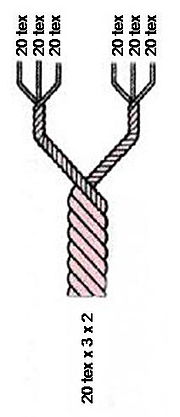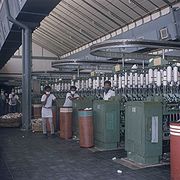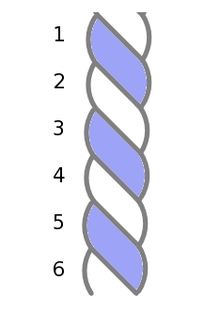- Units of textile measurement
-
Textile is measured in various units, such as: the denier and tex (linear mass density of fibres), super S (fineness of wool fiber), worst count, and yield (the inverse of denier and tex). Yarn is spun thread used for knitting, weaving, or sewing. Thread is a long, thin strand of cotton, nylon, or other fibers used in sewing or weaving. Both yarn and thread are measured in terms of cotton count and yarn density. Fabric is cloth, typically produced by weaving or knitting textile fibers, and is measured in units such as mommes (momme is a number that equals the weight in pounds of a piece of silk if it were sized 45 inches by 100 yards), thread count (a measure of the coarseness or fineness of fabric), ends per inch (e.p.i), and picks per inch (p.p.i).
Contents
Fiber/Fibre
Denier
Denier is a unit of measure for the linear mass density of fibers. It is defined as the mass in grams per 9,000 meters. In the International System of Units the tex is used instead (see below). The denier is based on a natural standard: a single strand of silk is one denier. A 9,000 meter strand of silk weighs one gram. The term denier is from a French coin of small value (worth 1/12 of a sou). Applied to yarn, a denier was held to be equal in weight to 1/24 oz (this does not have units of mass per length!).
The term micro-denier is used to describe filaments that weigh less than one gram per 9,000 meter length.
One can distinguish between Filament and Total denier. Both are defined as above but the first only relates to a single filament of fiber (also commonly known as Denier per Filament or D.P.F) whereas the second relates to a yarn, an agglomeration of filaments.
a unit of fineness for fibres
The following relationship applies to straight, uniform filaments:- D.P.F. = Total Denier / Quantity of Uniform Filaments
The denier system of measurement is used on two and single filament fibers. Some common calculations are as follows:
1 denier = 1 gram per 9 000 meters = 0.05 grams per 450 meters (1/20 of above) = 0.111 milligrams per meter In practice measuring 9,000 meters is both time-consuming and wasteful. Usually a sample of 900 meters is weighed and the result multiplied by 10 to obtain the denier weight.
- A fiber is generally considered a microfiber if it is 1 denier or less.
- A 1-denier polyester fiber has a diameter of about 10 micrometers.
- Denier is used as the measure of density of weave in tights and pantyhose, which defines their opacity.
One can calculate the diameter of a filament given its weight in denier with the following formula:

where ρ represents the material's density in grams per cubic centimeter and the diameter is in cm.
Tex
Tex is a unit of measure for the linear mass density of fibers and is defined as the mass in grams per 1000 meters. Tex is more likely to be used in Canada and Continental Europe, while denier remains more common in the United States and United Kingdom. The unit code is "tex". The most commonly used unit is actually the decitex, abbreviated dtex, which is the mass in grams per 10,000 meters. When measuring objects that consist of multiple fibers the term "filament tex" is sometimes used, referring to the mass in grams per 1000 meters of a single filament.
Tex is used for measuring fiber size in many products, including cigarette filters, optical cable, yarn, and fabric.
One can calculate the diameter of a filament given its weight in dtex with the following formula:

where ρ represents the material's density in grams per cubic centimeter and the diameter is in cm.
Tex (g/km) Yield (yards/#) 550 900 735 675 1100 450 1200 413 2000 250 2200 225 2400 207 4400 113 S or super S number
Super S or S number is a direct measure of the fineness of the wool fiber. It is most commonly seen as a label on wool suits and other tailored wool apparel to indicate the fineness of the wool fiber used in the making of the apparel. The numbers may also be found on wool fabric and yarn.
Worsted count
Worsted count (or spinning count) is an indirect measure of the fineness of the fiber in a worsted wool yarn expressed as the number of 560-yard [1] (1 yard = 0.9144 meters) lengths (hanks) of worsted yarn that a pound (0.45359237 kilograms) of wool yields. The finer the wool, the more yarn and the higher the count. It has been largely replaced by direct measures.
Yield
Similar to tex and denier, yield is a term that helps describe the linear density of a roving of fibers. However, unlike tex and denier, yield is the inverse of linear density and is usually expressed in yards/lb.
Yarn and thread
Cotton count
- Cotton Count is another measure of linear density. It is the amount of skein material measured in hanks (840 yards) needed to create one pound. Under this system, the higher the number, the finer the yarn. In the United States a cotton count between one and 20 are referred to as coarse counts. A regular single knit T-Shirt can be between 20 and 40 count, fine bed sheets are usually in the range of 40 to 80 count. The number is now widely used in the staple fiber industry.
- Hank: A length of 7 leas or 840 yards
One Lea – 120 yards
Yarn Length
Yarn Length in meters = Yarn countX1693XYarn Weight in Kgs
English Cotton count (Nec)is an indirect counting system i.e. the higher the number the finer the yarn.- Thread: A length of 54 in (the circumference of a warp beam)
- Bundle: Usually 10 lbs
- Lea: A length of 80 threads or 120 yards[2]
- Denier: this is an alternative method. It is defined as a number that is equivalent to the weight in grams of 9000m of a single yarn. 15 denier is finer than 30 denier.
- Tex: is the weight in grams of 1 km of yarn.[3]
To convert Denier to Cotton Count *5315 – from Tex * 590.5 Tex is 1/9 Denier
Thread
Thread is a cotton yarn measure, equal to 54 inches.
Yarn density conversion
Approx. Yarn Measurement Comparison Denier m/g Tex Worsted Cotton Woolen(Run) Linen(Lea) 50 180 5.6 160 106 56 298 75 120 8.3 106 72 37 198 100 90 11.1 80 53 28 149 150 60 16.6 53 35 19 99 200 45 22.2 40 27 14 74 300 30 33.4 27 18 9.3 50 400 22.5 44.4 20 13 7.0 37 500 18 55.5 16 11 5.6 30 700 12.9 77.7 11.4 7.6 4.0 2 1000 9 111 8.0 5.3 2.8 15 1500 6 166 5.3 3.5 1.9 10 2000 4.5 222 4.0 2.7 1.4 7 Fabric
Mommes
Mommes (mm) are units of weight traditionally used to measure the density of silk. It is akin to the use of thread count to measure the quality of cotton fabrics, but is calculated in a very different manner. Instead of counting threads, the Momme is a number that equals the weight in pounds of a piece of silk if it were sized 45 inches by 100 yards. This is because the standard width of silk is 45" wide, though silk is regularly produced in 55" widths, and, uncommonly, in even larger widths.
Silk can also be measured by weight in grams. 1 momme = 4.340 g/m^2; 8 momme is close to 1 oz per square yard or 34 g/m^2.
The usual range of momme weight for different weaves of silk are:
- Habutai – 5 to 16 mm
- Chiffon – 6 to 8 mm (can be made in double thickness, i.e. 12 to 16 mm)
- Crepe de Chine – 12 to 16 mm
- Gauze – 3 to 5 mm
- Raw silk – 35 to 40 mm (heavier silks appear more 'wooly')
- Organza – 4 to 6 mm
- Charmeuse – 12 to 30 mm –
The higher the momme, the more durable the weave, and the more suitable it is for heavy-duty use. And, the heavier the silk, the more opaque it becomes. This can vary even between the same kind of silk. For example, lightweight charmeuse is translucent when used in clothing, but 30mm charmeuse is opaque.
Thread count
Thread count is a measure of the coarseness or fineness of fabric. It is measured by counting the number of threads contained in one square inch of fabric or one square centimeter, including both the length (warp) and width (weft) threads. The thread count is the number of threads counted along two sides (up and across) of the square inch, added together.[4] It is used especially in regard to cotton linens such as bed sheets, and has been known to be used in the classification of towels.
Thread count is often used as a measure of fabric quality, so that "standard" cotton thread counts are around 150 while good-quality sheets start at 180 and a count of 200 or higher is considered percale. Some, but not all, of the extremely high thread counts (typically over 500) tend to be misleading as they usually count the individual threads in 'plied' yarns (a yarn that is made by twisting together multiple finer threads). For marketing purposes, a fabric with 250 two-ply yarns in both the vertical and horizontal direction could have the component threads counted to a 1000 thread count although "according to the National Textile Association (NTA), which cites the international standards group ASTM, accepted industry practice is to count each thread as one, even threads spun as two- or three-ply yarn. The Federal Trade Commission in an August 2005 letter to NTA agreed that consumers 'could be deceived or misled' by inflated thread counts.[5] In 2002, ASTM proposed a definition for "thread count" [6] that has been called "the industry's first formal definition for thread count".[7] A minority on the ASTM committee argued for the higher yarn count number obtained by counting each single yarn in a plied yarn and cited as authority the provision relating to woven fabric in the Harmonized Tariff Schedule of the United States, which states each ply should be counted as one using the "average yarn number."[8]
Ends per inch
Ends per inch (or e.p.i.) is the number of warp threads per inch of woven fabric.[9] In general, the higher the ends per inch, the finer the fabric is.
Ends per inch is very commonly used by weavers who must use the number of ends per inch in order to pick the right reed to weave with. The number of ends per inch varies on the pattern to be woven and the thickness of the thread. Plain weaves generally use half the number of wraps per inch for the number of ends per inch, whereas denser weaves like a twill weave will use a higher ratio like two thirds of the number of wraps per inch. Finer threads require more threads per inch than thick ones, and thus result in a higher number of ends per inch.
The number of ends per inch in a piece of woven cloth varies depending on what stage the cloth is at. Before the cloth is woven the warp has a certain number of ends per inch, which is directly related to what size reed is being used. After weaving the number of ends per inch will increase, and it will increase again after being washed. This increase in the number of ends per inch (and picks per inch) and shrinkage in the size of the fabric is known as the take-up. The take-up is dependent on many factors, including the material and how tightly the cloth is woven. Tightly woven fabric shrinks more (and thus the number of ends per inch increases more) than loosely woven fabric, as do more elastic yarns and fibers.
Picks per inch
Picks per inch (or p.p.i.) is the number of weft threads per inch of woven fabric.[9] A pick is a single weft thread,[9][10] hence the term. In general, the higher the picks per inch, the finer the fabric is.
References
- ^ Collier 1970, p. 74
- ^ Curtis 1921, p. Cotton count
- ^ Collier 1970, p. 3
- ^ Sheets.co.nz
- ^ Federal Trade Commission Letter retrieved from NTA website February 9, 2009
- ^ Revised Test Method Further Defines Fabric Count
- ^ Hometextilestoday.com "Down For the (Thread) Count"
- ^ Down For the (Thread) Count – 25 October 2004 – Home Textiles Today
- ^ a b c Curtis, H P (1921), "Glossary of Textile Terms", Arthur Roberts Black Book. (Manchester: Marsden & Company, Ltd. 1921), http://www.oneguyfrombarlick.co.uk/forum_topic.asp?whichpage=1&TOPIC_ID=6424&FORUM_ID=99&CAT_ID=3&Forum_Title=Rare+Text+(Book+Transcriptions)&Topic_Title=A+Glossary+of+Textile+Terms, retrieved 2009-06-23
- ^ "Pick." The Oxford English Dictionary. 2nd ed. 1989.
Bibliography
- Collier, Ann M (1970), A Handbook of Textiles, Pergamon Press, pp. 258, ISBN 0 08 018057 4, 0 08 018056 6
- Curtis, H P (1921), "Glossary of Textile Terms", Arthur Roberts Black Book. (Manchester: Marsden & Company, Ltd. 1921), http://www.oneguyfrombarlick.co.uk/forum_topic.asp?whichpage=1&TOPIC_ID=6424&FORUM_ID=99&CAT_ID=3&Forum_Title=Rare+Text+(Book+Transcriptions)&Topic_Title=A+Glossary+of+Textile+Terms, retrieved 2009-01-11
External links
Formulas]
Textile arts Fundamentals Applique · Beadwork · Crochet · Dyeing · Embroidery · Fabric (textiles) · Felting · Fiber · Knitting · Lace · Macramé · Nålebinding · Needlework · Patchwork · Passementerie · Plying · Quilting · Rope · Rug making · Sewing · Stitch · Spinning · Spinning by hand · Sprang · Tapestry · Tatting · Textile printing · Weaving · YarnHistory of ... Regional and ethnic Related Blocking · Fiber art · Mathematics and fiber arts · Manufacturing · Preservation · Recycling · Textile industry · Textile Museums · Units of measurement · Wearable fiber artReference Categories:- Units of density
- Textiles
Wikimedia Foundation. 2010.




